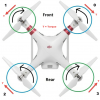If it was a Yaw error, what would that mean? Where is the FLY024.DAT file located? I can't find it so maybe it's gone.
A yaw error, mostly due to that the AC is powered on in a magnetic disturbed area, cause a flyaway in a straight or a toilet bowl shaped path (depending on how much the compass was thrown off) ... and that isn't what we see here.
Instead I think one prop blade from the left front motor was broken off or was damaged in some way.
Everything went well in the flight until approx 36sec ... the AC had then been piloted over the street & the house roofs there, turned around & was piloted back. The markers in the chart below is placed at 36sec ... all the time before that you commanded it over the street by means of elevator stick inputs (purple) & every time the AC answered with a speed increase (blue).

Just over the house (where the red circled star with the green bar is in the sat pic below) the AC start to rotate CW & at the same time pitch down & roll over to negative side (left).

Here below how yaw, pitch & roll change after 36sec...

Looking at the pic below we see that with a lost propulsion from either front left or rear right we lose one of 2 in total that torque the AC CCW, that means that the 2 CW gets the upper hand & the AC start to rotate CW ... that points to either the front left or the rear right.
As the AC initially pitch down, the front left looks most likely ... this is then confirmed by that the AC rolls over to the left. Both these motions due to a lost lift from the front left.

If the mobile .DAT log still was there (see post
#16 where it should be) we could probably see there how the FC had commanded the front left to 100% rpm's & lowered the other props in an attempt to balance out these uncommanded motions of the AC ... but it was doomed anyhow as only 3-3,5 props can't keep the Mini airborne anyway.
The bounce after it hits the roof makes me think that only one blade breaks & then you give full positive elevator stick into the wall in the end (see the first chart & the purple graph) ...














